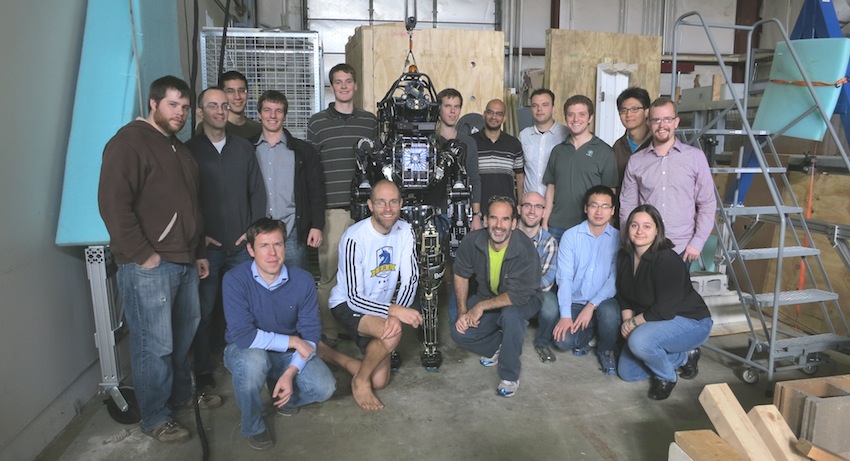MIT Robotics Team Brings Humanoid Machine To Life For National Competition

Photo Courtesy of the MIT DARPA Robotics Challenge Team
MIT Professor Seth Teller is in Florida, and walking, human-like robots are all around him.
“They are everywhere,” said Teller. “I feel like I have stepped into the future, and into a world where these robots are all over the place, doing useful work and doing what people are telling them to do.”
Teller is down South for the weekend as part of a robotics competition funded by the Defense Advanced Research Projects Agency, or DARPA.
In August, the governmental defense agency supplied MIT students and faculty with an ATLAS robot, built by Waltham-based Boston Dynamics, and tasked the group with programming the machine using sophisticated software.
Teller, who is leading the diverse group of computer scientists, mechanical, aeronautics, and astronautics engineers that make up the MIT DARPA Robotics Challenge Team, said they were gearing up their machine, which they spent months programming for this particular round of competitions against seven other groups, for Saturday’s live event.
“We are excited to be here. We got here, we unpacked, got the robot up and running in a couple of hours, and we were able to pretty much do here what we could do in Cambridge before we left,” he said. “It’s fantastic.”
The MIT team, co-led by Russ Tedrake, with the help of Dr. Maurice Fallon, the project’s perception and infrastructure lead, and Dr. Scott Kuindersma, the planning and control lead, is represented by 13 countries, and six continents worth of students who helped bring the ATLAS robot to life for the competition in Florida.
During The DARPA Robotics Challenge, which will be live-streamed on Saturday, December 21, teams will “attempt to guide their robots through eight individual, physical tasks that test mobility, manipulation, dexterity, perception, and operator control mechanisms.”
The robots will perform tasks such as climbing over cinder blocks, driving a car, and scaling a ladder.
Teller said points for the competition will be based on how well the robots conquer each challenge.
“They have laid it all out so it can be done in a repeatable and fair way,” he said. “They are scoring us based on whether we complete the tasks and all of the subtasks and how fast we complete them.”
The challenge was created in the wake of the Tsunami in Japan in 2011, which led to the meltdown of the Fukishima Power Plant. DARPA officials said if they had mobile machines that could perform human tasks, it might have been possible to maneuver through rubble and debris to help save those impacted by the natural disaster.
According to DARPA, this weekend’s trials will provide a baseline on the current state of robotics, and determine which teams will continue on to the DRC Finals in 2014 with continued DARPA funding. Competing in the 2014 Finals will lead to one team winning a $2 million prize.
But Teller said he is less concerned about the $2 million prize, and just excited to have come this far, and bring an advanced machine like the ATLAS to life with his team of dedicated students.
“We aren’t in it for the prize. We are in it to tackle the really hard technical problems,” he said.
Teller believes the day is fast approaching when people will be living among humanoid machines like the ATLAS, and he is excited to be on the forefront of the technology.
“That day is coming, we will all have these machines. We are all going to have one of these robots, and that day is not too far away. They won’t look like they will now, they will be sleeker, tighter, and a lot more capable. What we are seeing here at the competition is the very, very first step toward that world,” he said.
MIT isn’t the only Massachusetts team competing in the competition. Students from the Robotics and Intelligent Vehicles Research Laboratory at Worcester PolyTechnic Institute also had the chance to work with the ATLAS robot of their own, and are down in Florida to see if they can clinch the title.
In July, when the school of engineers was chosen, they told Boston they were honored to be part of the process, and represent the state.
“This is a really big deal. It’s a big deal for a lot of obvious reasons. But besides exposure for our team, we are getting a brand new toy,” said RJ Linton, a Ph.D. Candidate in the Robotics Engineering program at WPI.
Below is a video of MIT’s ATLAS project:

